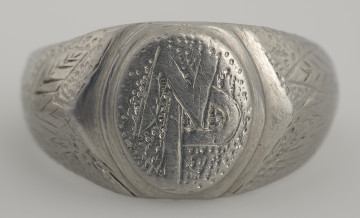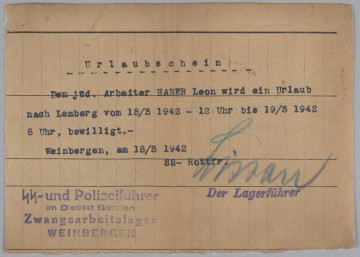
Ring
1939 — 1945
Museum of the history of Polish Jews
Part of the collection: Mementos from the Łódź ghetto
Since 24 June 1940, the Lodz Ghetto had its own currency. It was the only ghetto in occupied Poland that issued its own money. The Jews living there were forced to exchange their money into brand-name notes (German: Quittung), referring to the currency used in Germany at that time - marks and pfennigs. However, the coins and banknotes functioning in the Lodz ghetto were marked in a way that raised no doubts about their place of functioning. They bore symbols of barbed wire, the Star of David (coins) or menorahs (banknotes), as well as inscriptions in German informing that the coins were in use in the ghetto (Getto) and that they were issued by the Jewish Council in Lodz (Der Aelteste der Juden in Litzmannstadt). Ghetto money had no value outside the ghetto walls. The introduction of a separate currency was supposed to increase the isolation of the ghetto population and make it impossible to bribe guards or officials, and prevent contraband. The marker notes used in the ghetto were also commonly called rumkas or, more rarely, chaimkas (from the name of Chaim Rumkowski, the chairman of the Jewish Council).
The fact that the 10-mark coin from the Lodz ghetto, which is in POLIN's collection, has been framed with a decorative wire (metal bow) bent in such a way that it can be placed in a lapel or a pocket of clothing suggests that it could have been used as an element of jewelry, which was confiscated from the Jews resettled to the ghetto.
The coin is round, silver, and has a metal clasp. Obverse: In the centre, there is a Star of David surrounded by barbed wire. Below the inscription: GETTO 1943 Reverse: in the centre the number 10 with a ribbon with the inscription QUITTING ÜBER (German: receipt of receipt), below it, an inscription MARK (German: mark). In the rim the inscription: DER AELTESTE DER JUDEN IN LITZMANNSTADT (German: Jewish Council in Lodz).
Marta Frączkiewicz
Author / creator
Dimensions
cały obiekt: height: 3,3 cm, width: 5,3 cm
Technique
Stamping, soldering
Material
metal
Creation time / dating
Creation / finding place
Owner
POLIN Museum of the History of Polish Jews
Identification number
Location / status

1939 — 1945
Museum of the history of Polish Jews
1944
Museum of the history of Polish Jews

1942
Museum of the history of Polish Jews
DISCOVER this TOPIC
National Museum in Szczecin
DISCOVER this PATH
Educational path